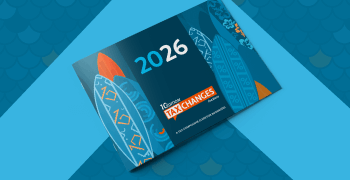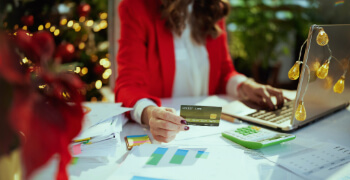
How to 86 stress by automating your restaurant sales tax
Restaurants are always there for us, whether we’re celebrating a special occasion, need a quick bite on the go, or just don’t feel like cooking. They fed us during the worst of the COVID-19 pandemic under the most challenging circumstances. From behind masks they served us with a smile because that’s what restaurants do. (Unless they’re Hawthorn of “The Menu” fame.)
As a restaurant owner or manager, you know it’s not easy. The hours are often grueling; finding and retaining reliable staff is a constant struggle; and margins are almost always tight. While restaurant profit margins can vary widely depending on the location and type of establishment, the pretax profit margin for a typical restaurant is roughly 5%.
Margins that thin make it difficult to deal with the cost increases U.S. restaurants have experienced since inflation took hold. “[A] strong majority of operators say their costs are higher now than they were in 2019,” according to a National Restaurant Association survey of 4,200 restaurants fielded July 14–August 5, 2022. Food and beverage costs alone had jumped 21.8% at the time of the survey; labor costs were up 18.3%.
Little wonder that 85% of operators surveyed said “their restaurant is less profitable now (July/August 2022, the time of the survey) than it was in 2019 before the pandemic.” Even when sales are relatively robust, as they reportedly were in March 2023, higher inputs keep profit margins down.
There are probably as many ways for restaurants to shave costs as there are to cook a fish. But one thing restaurants can’t cut out is sales tax.
How does restaurant sales tax work?
Restaurants don’t pay sales tax out of pocket, the way they pay income tax, business and operating (B&O) tax, or franchise tax. Consumers pay restaurant sales tax: Restaurants collect sales tax from customers, hold on to it for a time, then remit the sales tax due to the appropriate tax authority when filing their monthly return. That’s the way sales tax generally works in all industries.
Although most grocery-type foods are exempt from sales tax in most states, all states tax the prepared food sold by restaurants. And there’s a lot about restaurant sales tax that’s particularly complicated.
Understanding the challenges of restaurant sales tax
Figuring out which sales tax rate applies to restaurant sales. While calculating sales tax on restaurant food can be relatively straightforward for restaurants that only sell food for in-house dining in one location, rates for delivery sales can be different.
Sales tax rates in most states are based on the location where the consumer took possession of the goods, in this case the prepared food. So, when a restaurant delivers food to a consumer located in a different sales tax jurisdiction than the restaurant, the restaurant typically has to apply the rate in effect at the delivery location rather than the rate in effect at the restaurant where the order was taken.
Determining whether delivery charges and gratuities are subject to restaurant sales tax. Taxability rules vary from state to state, so while some states tax restaurant delivery charges, others may not. Gratuities are often subject to sales tax when included in the sale price (e.g., a mandatory 15% gratuity for parties of six or more), but generally aren’t taxable when tacked on at the whim of the consumer.
Comprehending the tax implications of complimentary or employee meals, coupons, etc. Many restaurants allow employees to have one meal per shift and occasionally comp meals to disgruntled customers. Sales tax doesn’t usually apply to restaurant food provided at absolutely no cost, but if there’s a specific charge for such meals (e.g., the employee pays cash for the meal, or the value of the meal is deducted from the employee’s paycheck, etc.), those amounts are generally taxable.
Furthermore, as the Texas Comptroller explains, “while complimentary meals and drinks are not taxable, tax is due on the taxable ingredients used in their preparation. For example, the raw meat and vegetables used to prepare a complimentary meal are not taxable, but a restaurant should accrue tax on soft drinks and other taxable items that are given away.”
Coupons can also complicate sales tax compliance. You may need to subtract the value of the coupon before calculating sales tax on the bill, or you may need to subtract it after applying sales tax to the original amount. As the New York State Department of Taxation and Finance explains, how coupons affect restaurant sales tax depends on the type of coupon being used.
Understanding restaurant sales tax exemptions. There are some pretty wacky sales tax rules related to sales tax exemptions and sales of prepared food. Take California’s 80/80 rule, which applies when more than 80% of the food you sell is taxable. If the 80/80 rule applies and you don’t separately track sales of cold food products sold to-go (e.g., bakery items, fruit smoothies, salads, and sandwiches), you’ll owe tax on 100% of your sales. But if the 80/80 rule doesn’t apply, sales of cold food products sold individually to-go usually aren’t taxable. Clear as a dirty chai, right?
Food deliveries are considered to-go sales in California, so depending on where your business falls under the 80/80 rule, deliveries of cold food products may or may not be taxable. On the other hand, hot prepared food would be taxable whether or not the 80/80 rule applies, because it’s hot.
The kicker with the 80/80 rule is that if it applies and you decide to take advantage of it, you’ll have to separately account for to-go sales of food products. “Without adequate documentation,” cautions the California Department of Tax and Fee Administration (CDTFA), “100% of your sales are subject to sales tax under the 80/80 rule.”
Washington state has a similar but different rule for exemptions for prepared food, the 75% rule. And these are just the tip of the iceberg when it comes to unusual sales tax rules related to food.
Selling through a third party. Third-party ordering services and delivery apps have become an essential sales channel for many restaurants, for better or worse. One of the more challenging aspects of such business relationships is determining who’s responsible for collecting, remitting, and reporting the tax on sales made through third-party platforms — the restaurant or the platform. Another is ensuring the customer doesn't end up paying sales tax twice, once to you and once to the third-party.
CDTFA urges restaurants and online ordering service providers to have a written agreement that clearly describes whether the third-party is “acting as an agent of the restaurant” or “purchasing the meals for resale.” The relationship between the restaurant and third-party delivery app affects sales tax: In California, if the restaurant is considered the retailer, it’s liable for tax on the full selling price without any deduction of the commission retained by the service provider. But if a third-party purchases the meals for resale, it’s considered the retailer and is liable for the tax due on sales made through the platform.
Sales tax rules for third-party food ordering and delivery platforms differ from state to state, so if you operate in more than one state, you may need to treat such sales differently, for tax purposes.
Remitting and reporting sales tax. Reporting sales tax can be complicated by all of the above situations and by other factors. Additionally, sales tax returns must be properly completed and filed on time, along with the sales tax, every time.
Simply remitting the collected sales tax should be one of the easiest aspects of sales tax compliance. However, for businesses operating on mandoline-thin margins, it can be one of the trickiest tasks.
The hidden cost of restaurant sales tax
If sales tax monies are mingled with general operating funds in a restaurant’s checking account, it can be all too easy to spend it when bills are due and it’s time to make payroll. And that could be fine, so long as there’s money to hand over to the appropriate tax authorities when it’s time to report and remit sales tax.
Unfortunately, there may not be.
If you depleted your account to cover expenses and therefore can’t remit the sales tax when it’s due, you risk incurring late fees, penalties, and interest. Once you can pay what you originally owed, you may find you owe more than expected — even if you were only late by a few days.
Texas assesses a $50 penalty on each sales tax report filed after the due date, and a 5% penalty on tax paid one to 30 days after the due date. A 10% penalty applies to tax paid more than 30 days after the due date. Interest on past-due charges kicks in 61 days after the due date.
In New York, if a restaurant owes additional taxes (uncovered during an audit or any other time), “it will also be subject to penalties and interest.” Failure to pay the sales tax due on New York restaurant sales can ultimately lead to the suspension or revocation of the restaurant’s certificate of authority, which gives it the right to collect sales tax and issue or accept sales tax exemption certificates.
How automation helps restaurants manage sales tax
Perhaps the easiest way for a restaurant to avoid spending sales tax monies is to keep it separate from the get-go. If it never makes it into your checking account, you’ll never have the opportunity to spend it.
DAVO by Avalara does just that: It sets aside your sales tax daily, so you’ll be sure to have it when you need it. It stores sales tax monies in a secure holding account, so you don’t need to keep track of how much money in your account actually belongs to the state. Keeping sales tax in a completely separate account gives you a more accurate picture of the working capital actually available to your business.
At the end of the reporting period, DAVO also files and and remits sales tax on your behalf. This allows you to focus on running your restaurant rather than getting mired in bookkeeping.
How does sales tax automation for restaurants work?
DAVO integrates with your restaurant’s existing point-of-sale (POS) system. It automatically imports POS data daily and sets sales tax aside each day, and it automatically prepares and files sales tax returns and remits sales tax.
Users see a monthly view of sales and sales tax on the dashboard and receive daily “set aside” emails that let you know the total daily sales amount and how much sales tax was set aside. You can also export “set aside” data via CSV, by account or location. Other features that help with restaurant sales tax reporting and recordkeeping include the ability to see historical lists of filed returns and download copies of filed returns.
You probably don’t commit to purchase food ingredients from a new supplier until you’ve confirmed the quality of their products meets your standards. Likewise, you may be hesitant to purchase technology before knowing whether it can actually add value. So, you can try your first monthly filing with DAVO by Avalara at no cost when you sign up.
Dealing with sales tax is an unavoidable part of the restaurant industry, like dealing with grumpy customers or washing lettuce. No restaurant wants sales tax compliance on their plate. So why not give DAVO by Avalara a try?

Avalara Tax Changes 2026 is here
The 10th edition of our annual report engagingly breaks down key policies related to sales tax, tariffs, and VAT.
Stay up to date
Sign up for our free newsletter and stay up to date with the latest tax news.














